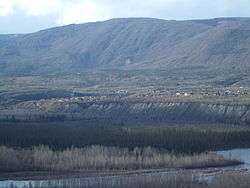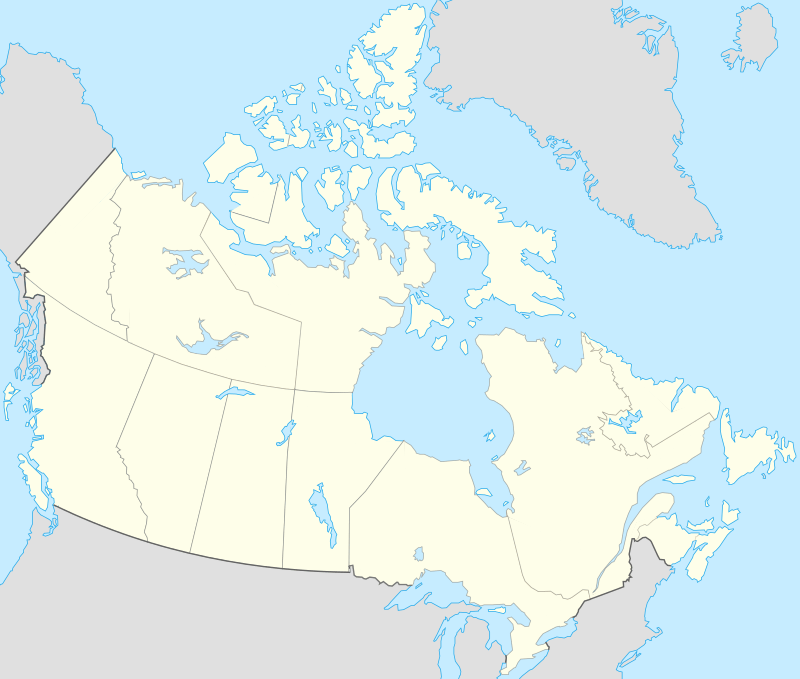Faro, Yukon
Faro is a town in the central Yukon, Canada, formerly the home of the Faro Mine, the largest open pit lead–zinc mine in the world as well as a significant producer of silver and other natural resource ventures. The mine was built by the Ralph M. Parsons Construction Company of the USA with General Enterprises Ltd. of Whitehorse being the main subcontractor. As of 2011, the population is 344, considerably lower than its peak of over 2,100 in February 1982. Faro was named after the card game.[1] credited with discovering several significant deposits of lead and zinc ore and playing a major role in the discovery of the Faro Mine, which became Canada's largest lead-zinc mine.[2]
Faro | |
|---|---|
 Town of Faro | |
 Faro | |
| Coordinates: 62°13′59″N 133°19′59″W | |
| Country | Canada |
| Territory | Yukon |
| Area | |
| • Land | 203.57 km2 (78.60 sq mi) |
| Population (2011) | |
| • Total | 344 |
| • Density | 1.7/km2 (4/sq mi) |
| • Change 2006-11 | |
| Time zone | UTC−08:00 (PST) |
| • Summer (DST) | UTC−07:00 (PDT) |
| Climate | Dfc |
As these industries have declined over the past decade, Faro is attempting to attract eco-tourists to the region to view such animals as Dall's sheep and Stone's sheep, a species of mountain sheep almost unique to the surrounding area. Several viewing platforms have been constructed in and around the town.
One unusual feature of Faro is that it has a golf course running through the main part of town.[3]
Lorne Greene, famous for his work in Bonanza, once narrated a film about Faro called A New World in the Yukon.
History
The area was prospected in the 1950s and 1960s by Al Kulan,[1] credited with discovering several significant deposits of lead and zinc ore and playing a major role in the discovery of the Faro Mine, which became Canada's largest lead-zinc mine.[2] The Cyprus Anvil Mining Corporation[1] established the first operations to mine the deposits, and established the town of Faro. A new highway was built between Carmacks and Ross River to serve the Faro area - initially numbered Highway 9, it is today part of the Robert Campbell Highway, Yukon Highway 4. A forest fire in 1969 destroyed the newly built homes, which had to be re-built.
Faro Mine
The mine was opened by the Cyprus Anvil Mining Corporation in 1969, which was formed to mine the deposit.[4] From the late 1960s until 1982 the mine became one of the largest lead-zinc mines in the world. At one time it was the largest open-pit mine in the world. During its history, 320 million tonnes of waste rock was removed to access the ore. The mine remained in more-or-less constant production until 1982. Trucks carried the ore concentrate from the mill by highway to Whitehorse, where the buckets were lifted from the trucks and lowered onto cars of the White Pass and Yukon Route railway. The trains took the buckets another 106 miles to Skagway, Alaska, where the contents were poured out into the holds of ships.
During those years, Cyprus Anvil was purchased by Dome Petroleum. World prices for metals fell in 1982, and the mine owners announced in May a two-month halt to production starting in June, 1982. In July, the mine owners extended the shutdown to four months. In September, the owners announced that the shutdown would be indefinite. The shock to the Yukon economy, where the mine produced approximately 40% of territorial GDP, was massive.[5] With government assistance an 18-month waste-rock stripping program was operated in 1983 and 1984. Curragh Resources purchased the property in 1985 and production resumed in 1986.[6] This time, ore was trucked in ore pots from Faro directly to Skagway, bypassing the railway. This operation ended in 1993, not long after Curragh Resources suffered a coal mining disaster at the Westray Mine in Plymouth, Pictou County, Nova Scotia. A third operation, by the Anvil Range Mining Corporation, opened in 1995 and ceased production in January 1998, followed by the bankruptcy of Anvil Range. Much of the heavy mining and milling equipment was sold and removed from the Yukon.
Any prospect for further mining of the lead-zinc resource would now require significant investment to bring in mining equipment, and it would need to come entirely by road unless a B.C.-Alaska railway is built or the White Pass route is reopened to freight traffic to Whitehorse. Cost of cleanup is estimated at close to a billion dollars.[7]
When the mine closed it left 70 million tonnes of tailings and 320 million tonnes of waste rock that require remediation to protect the health of humans, land, water, and wildlife.[8] The clean up bill for the mine and tailings pond fell to the federal government. Early estimates put the cost at $450–590M over 40 years. In 2016 the federal Treasury reported that between $250 million and $350 million had been spent maintaining the mine site, without starting cleanup. The $40 million annual costs are to run pumps to prevent the tailings from breaching the dams. The cleanup itself could cost a further $1-billion.[9]
Transportation
The town is served by the Faro Airport.
Climate
Faro has a subarctic climate (Köppen Dfc) with mild summers and severely cold winters. Extreme seasonal swings are common, although less severe than farther east in Canada due to the warm spells in summers and occasional mild spells in winter.
| Climate data for Faro Airport | |||||||||||||
|---|---|---|---|---|---|---|---|---|---|---|---|---|---|
| Month | Jan | Feb | Mar | Apr | May | Jun | Jul | Aug | Sep | Oct | Nov | Dec | Year |
| Record high humidex | 5.4 | 10.8 | 11.4 | 19.6 | 29.7 | 35.4 | 33.9 | 32.8 | 23.9 | 17.8 | 12.0 | 11.7 | 35.4 |
| Record high °C (°F) | 7.0 (44.6) |
12.1 (53.8) |
12.5 (54.5) |
21.5 (70.7) |
32.0 (89.6) |
33.8 (92.8) |
31.0 (87.8) |
33.9 (93.0) |
24.0 (75.2) |
18.5 (65.3) |
12.5 (54.5) |
12.5 (54.5) |
33.9 (93.0) |
| Average high °C (°F) | −16.0 (3.2) |
−10.3 (13.5) |
−2.1 (28.2) |
6.8 (44.2) |
13.8 (56.8) |
19.6 (67.3) |
21.0 (69.8) |
18.4 (65.1) |
11.5 (52.7) |
1.7 (35.1) |
−11.1 (12.0) |
−13.8 (7.2) |
3.3 (37.9) |
| Daily mean °C (°F) | −20.1 (−4.2) |
−15.5 (4.1) |
−8.6 (16.5) |
0.6 (33.1) |
7.5 (45.5) |
13.2 (55.8) |
15.0 (59.0) |
12.4 (54.3) |
6.4 (43.5) |
−2.0 (28.4) |
−14.8 (5.4) |
−17.9 (−0.2) |
−2.0 (28.4) |
| Average low °C (°F) | −24.6 (−12.3) |
−20.7 (−5.3) |
−15.0 (5.0) |
−5.5 (22.1) |
1.2 (34.2) |
6.8 (44.2) |
8.9 (48.0) |
6.3 (43.3) |
1.3 (34.3) |
−5.7 (21.7) |
−18.5 (−1.3) |
−22.3 (−8.1) |
−7.3 (18.9) |
| Record low °C (°F) | −51.0 (−59.8) |
−51.0 (−59.8) |
−44.0 (−47.2) |
−30.5 (−22.9) |
−8.0 (17.6) |
−2.5 (27.5) |
0.0 (32.0) |
−4.5 (23.9) |
−15.5 (4.1) |
−34.0 (−29.2) |
−46.0 (−50.8) |
−52.0 (−61.6) |
−52.0 (−61.6) |
| Record low wind chill | −59.1 | −58.9 | −53.1 | −34.2 | −16.4 | 0.0 | 0.0 | −2.4 | −13.0 | −30.4 | −58.3 | −60.0 | −60.0 |
| Average precipitation mm (inches) | 14.6 (0.57) |
12.3 (0.48) |
12.3 (0.48) |
8.7 (0.34) |
27.9 (1.10) |
36.7 (1.44) |
56.1 (2.21) |
48.2 (1.90) |
41.0 (1.61) |
27.3 (1.07) |
19.4 (0.76) |
15.2 (0.60) |
319.7 (12.59) |
| Average rainfall mm (inches) | 0.0 (0.0) |
0.0 (0.0) |
0.1 (0.00) |
2.6 (0.10) |
27.3 (1.07) |
36.7 (1.44) |
56.1 (2.21) |
47.5 (1.87) |
38.4 (1.51) |
9.4 (0.37) |
0.2 (0.01) |
0.1 (0.00) |
218.4 (8.60) |
| Average snowfall cm (inches) | 16.7 (6.6) |
14.6 (5.7) |
13.1 (5.2) |
6.3 (2.5) |
0.6 (0.2) |
0.0 (0.0) |
0.0 (0.0) |
0.7 (0.3) |
2.4 (0.9) |
20.4 (8.0) |
21.7 (8.5) |
17.6 (6.9) |
114.0 (44.9) |
| Average precipitation days (≥ 0.2 mm) | 10.7 | 8.6 | 7.3 | 5.3 | 11.6 | 12.7 | 17.7 | 15.2 | 15.2 | 13.9 | 12.5 | 10.8 | 141.4 |
| Average rainy days (≥ 0.2 mm) | 0.0 | 0.0 | 0.1 | 1.5 | 11.2 | 12.7 | 17.7 | 15.0 | 14.2 | 5.0 | 0.2 | 0.1 | 77.8 |
| Average snowy days (≥ 0.2 cm) | 11.1 | 8.9 | 7.4 | 4.0 | 0.6 | 0.0 | 0.0 | 0.2 | 1.4 | 9.5 | 12.9 | 11.4 | 67.4 |
| Average relative humidity (%) | 79.2 | 71.9 | 54.8 | — | — | 41.4 | 47.9 | 50.4 | 55.4 | 63.7 | 81.2 | 81.0 | 62.7 |
| Source: Environment Canada Canadian Climate Normals 1981–2010[10] | |||||||||||||
See also
- List of municipalities in Yukon
- Canadian mining hall of fame
References
- "History of Faro". Town of Faro: Yukon's Best Kept Secret. 2004. Archived from the original on 16 May 2012. Retrieved 2012-07-30.
- Guest, H. (2012). "Faro". The Canadian Encyclopedia. Historica-Dominion. Retrieved 30 July 2012.
- Quilici, Don (18 July 2012). "Outdoors with Don Q: The Yukon's infamous Robert Campbell Highway". Carson Now. Carson City News, Carson, Nevada. Retrieved 28 July 2012.
- What's the Big Picture: Yukon's Large Contaminated Sites, Indigenous and Northern Affairs Canada. Retrieved 2017-01-05
- Down and out in the Yukon Territory, New York Times, July 28, 1985. Retrieved 2017-01-05 frepubli
- The Northern Miner 1987 “Mining Person of the Year” Clifford Hugh Frame, The Northern Miner, January 11, 2009. Retrieved 2017-01-05
- Merit Consultants International Ltd.; responsible for projected clean-up cost reports. Jan, 2010
- Faro Mine Remediation. Retrieved 2017-01-05
- Two decades after closure of Yukon's Faro Mine, a cleanup plan takes shape. The Globe and Mail, January 3, 2017. Retrieved 2017-01-05
- "Faro A" (CSV (2874 KB)). Canadian Climate Normals 1981–2010. Environment Canada. Climate ID: 2100517. Retrieved 20 February 2014.